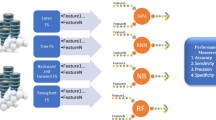Abstract
Prediction of Parkinson disease (PD) in an early stage is important since the disease is not curable at later stages. Many machine algorithms have been used in the currently available works to obtain a precise result. Most of the algorithms are based on random forest, Decision tree, linear regression, support vector machine (SVM), and Naïve Bayes. This paper uses four classifiers such as J48, NB-tree, multilayer perceptron neural network (MPNN), and SVM. These approaches are used to classify the Parkinson disease dataset without applying attribute selection approaches. The dataset for the work is collected from UCI Parkinson repository. The performances of the proposed four classifiers are evaluated on the original dataset, discretized dataset, and selected attributes. Based on the outcome of the study, J48 achieves high accuracy on discretized dataset. MPNN performs well with better accuracy without attribute selection and discretization on PD dataset. The results showed that SVM achieved the highest accuracy of 95.05% on the non-discretized dataset, followed by MPNN with 94.06% accuracy. J48 achieved the highest accuracy of 94.12% on the discretized dataset, followed by SVM with 93.04% accuracy. From the observation, we came to know that except MPNN all the classifiers perform well on data discretization.






Similar content being viewed by others
Data availability
Available on request.
References
Aich S, Joo MI, Kim HC, Park J (2019) Improvisation of classification performance based on feature optimization for differentiation of Parkinson’s disease from other neurological diseases using gait characteristics. Int J Electr Comput Eng 9:5176–5184
Alemami Y, lmazaydeh L (2016) Detecting of Parkinson disease through voice signal features. J Am Sci 3:11
Aström F, Koker R (2011) A parallel neural network approach to prediction of Parkinson’s disease. Expert Syst Appl 38:12470–12474
Azad C, Jain S, Jha VK (2014) Design and analysis of data mining-based prediction model for Parkinson’s disease. Int J Comput Sci Eng 3:181–189
Chen HL, Wang G, Ma C, Cai ZN, Liu WB, Wang SJ (2016) An efficient hybrid kernel extreme learning machine approach for early diagnosis of Parkinson’s disease. Neurocomputing 184:131–144
Das R (2010) A comparison of multiple classification methods for diagnosis of Parkinson disease. Expert Syst Appl 37:1568–1572
Fayyad U, Irani K (1993) Multi-interval discretization of continuous-valued attributes for classification learning. In: Proceedings of the 13th international joint conference on artificial intelligence. IJCAI, California, pp 1022–1027
Fayyazifar N, Samadiani N (2017) Parkinson’s disease detection using ensemble techniques and genetic algorithm. In: Proceedings of the artificial intelligence and signal processing conference (AISP), Shiraz
Grover S, Bhartia S, Akshama Y, Seeja KR (2018) Predicting severity of Parkinson’s disease using deep learning. Proc Comput Sci 132:1788–1794
Hsu CW, Chang CC, Lin CJ (2016) A practical guide to support vector classification. Technical report, Department of Computer Science and Information Engineering, National Taiwan University. Retrieved from http://www.csie.ntu.edu.tw/cjlin/libsvm/
Ibrahim A, Zhou Y, Jenkins ME, Trejos AL, Naish MD (2020) The design of a Parkinson's tremor predictor and estimator using a hybrid convolutional-multilayer perceptron neural network. In: Proceedings of the IEEE Canadian conference on electrical and computer engineering, Canada, pp 1–6
Kirubha V, Priya SM (2016) Survey on data mining algorithms in disease prediction. Int J Comput Trends Technol 38:124–128
Li DC, Liu CW, Hu SC (2011) A fuzzy-based data transformation for feature extraction to increase classification performance with small medical data sets. Artif Intell Med 52:45–52
Mathur R, Pathak V, Bandil D (2019) Parkinson disease prediction using machine learning algorithm. In: Proceedings of the emerging trends in expert applications and security. Springer, Singapore, pp 227–236
Olanrewaju RF, Sahari NS, Musa AA, Hakiem N (2014) Application of neural networks in early detection and diagnosis of Parkinson’s disease. In: Proceedings of the international conference on cyber and IT service management. IEEE Xplore, S.Tangerang, pp 67–70
PD dataset from UCI repository. (n.d.). Retrieved March 10, 2023, from https://archive.ics.uci.edu/ml/machine-learning-databases/parkinsons/
Sakar C, Kursun O (2010) Telediagnosis of Parkinson’s disease using measurements of dysphonia. J Med Syst 34:1–9
Saloni RK, Gupta AK (2015) Detection of Parkinson disease using clinical voice data mining. Int J Circuit Syst Signal Process 9:320–326
Shirvan RA, Tahami E (2011) Voice analysis for detecting Parkinson's disease using genetic algorithm and KNN classification method. In: Proceedings of the 18th Iranian conference of biomedical engineering (ICBME), Tehran
Zahari AB, Dzufi I, Nur FI, Nooritawati MT (2012) Classification of Parkinson's disease based on multilayer perceptrons (MLPs) neural network and ANOVA as a feature extraction. In: Proceedings of the 8th IEEE international colloquium on signal processing and its applications, Malaysia, pp 261–264
Funding
Not applicable.
Author information
Authors and Affiliations
Contributions
KK, GA, and MAG contributed equally to this work. KK and GA conducted the experiments, analyzed the results, and wrote the initial manuscript. MAG reviewed and edited the manuscript, helps in revision process, providing valuable feedback and suggestions for improvement. All authors discussed the results, interpreted the findings, and approved the final version of the manuscript.
Corresponding author
Ethics declarations
Conflict of interest
Authors declare no conflict of interest.
Ethical approval
Not applicable.
Additional information
Publisher's Note
Springer Nature remains neutral with regard to jurisdictional claims in published maps and institutional affiliations.
Rights and permissions
Springer Nature or its licensor (e.g. a society or other partner) holds exclusive rights to this article under a publishing agreement with the author(s) or other rightsholder(s); author self-archiving of the accepted manuscript version of this article is solely governed by the terms of such publishing agreement and applicable law.
About this article
Cite this article
Kamalakannan, K., Anandharaj, G. & Gunavathie, M.A. Performance analysis of attributes selection and discretization of Parkinson’s disease dataset using machine learning techniques: a comprehensive approach. Int J Syst Assur Eng Manag 14, 1523–1529 (2023). https://doi.org/10.1007/s13198-023-01960-x
Received:
Revised:
Accepted:
Published:
Issue Date:
DOI: https://doi.org/10.1007/s13198-023-01960-x




